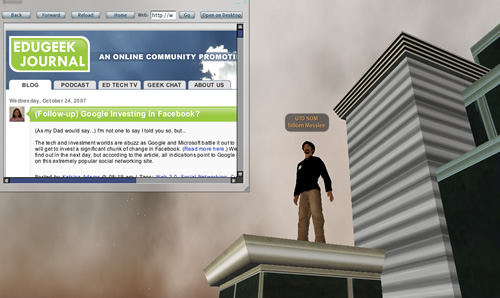This is something straight out of Sci-Fi, but it is for real. 3-D scanners have existed for a while, apparently, but now they are coming down in price. 3-D printers are still expensive, but something that is possibly coming to a place like Kinko’s soon.
The New York Times had an article about this technology. You put an object on the scanner, the object gets scanned with a laser, and then you have a 3-D scan of a 3-D object. If you have something too big for the scanner, they also have laser devices like a camera that can take care of those. Then, you can edit the 3-D object in a computer program. Scanners start at $2500 and go up to nearly $40,000 for the camera, just in case you want to start saving up (to buy me one of course).
They also have the 3-D “printers” that can re-create the objects, in full color, using a resin or a starch-based powder. Sweet.
I’m thinking that, other than being cool, this could also be a giant leap forward for Second Life. The $2500 scanner is for desktops. The way the computer world goes, that will come down to about $250 in 2 years, right? So, want to create a realistic avatar of yourself? Want to recreate your favorite chair, coffee mug, chia-pet, or what ever in Second Life? What ever you want to transfer into Second Life will be a realistic possibility in the future.
The educational possibilities for the 3-D printer are also endless, as soon as the cost comes down. Ancient artifacts could be scanned and “faxed” to classrooms everywhere. Distance art education could become a reality. Of course, there are also new legal issue to wrangle with. The Time article linked above deals with those issues and some other ideas.
I’m ready for my Holodeck now….
Matt is currently an Instructional Designer II at Orbis Education and a Part-Time Instructor at the University of Texas Rio Grande Valley. Previously he worked as a Learning Innovation Researcher with the UT Arlington LINK Research Lab. His work focuses on learning theory, Heutagogy, and learner agency. Matt holds a Ph.D. in Learning Technologies from the University of North Texas, a Master of Education in Educational Technology from UT Brownsville, and a Bachelors of Science in Education from Baylor University. His research interests include instructional design, learning pathways, sociocultural theory, heutagogy, virtual reality, and open networked learning. He has a background in instructional design and teaching at both the secondary and university levels and has been an active blogger and conference presenter. He also enjoys networking and collaborative efforts involving faculty, students, administration, and anyone involved in the education process.
